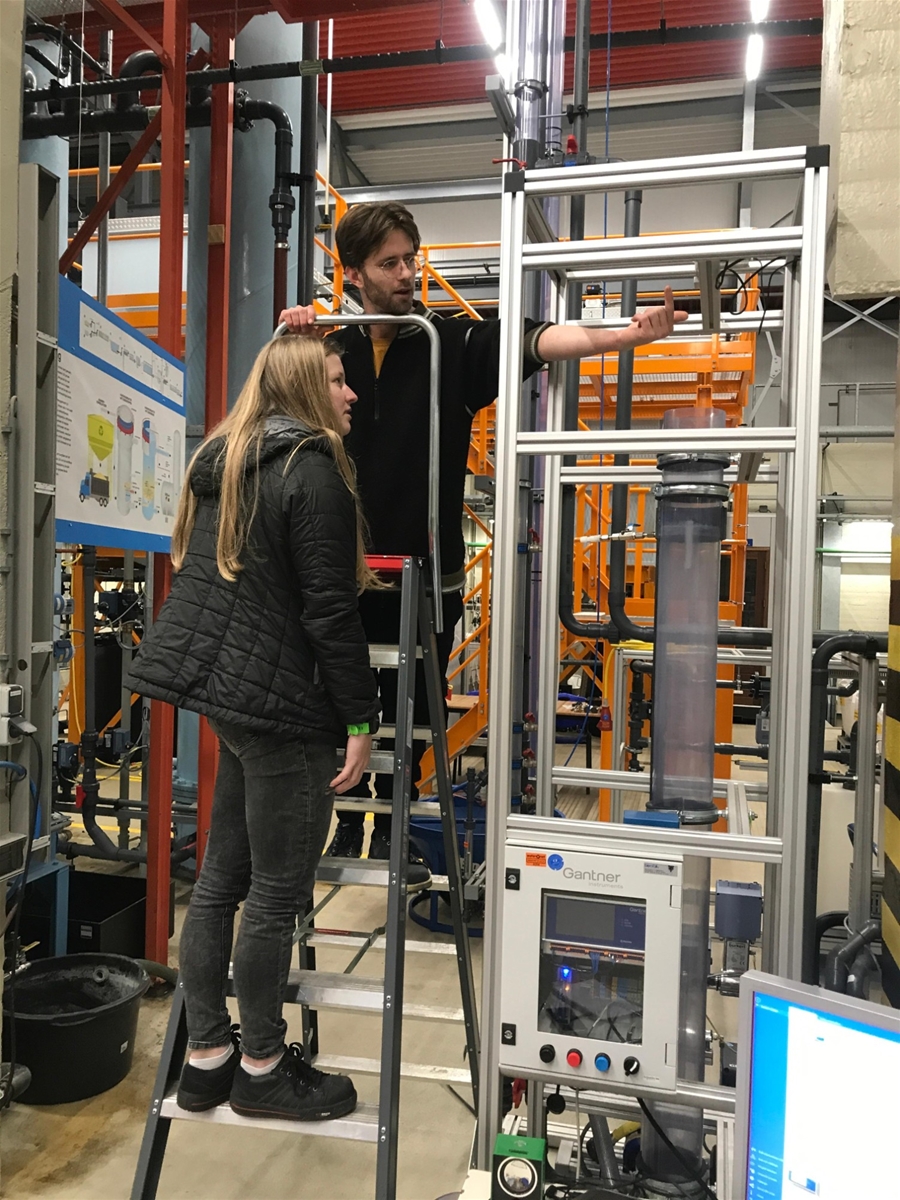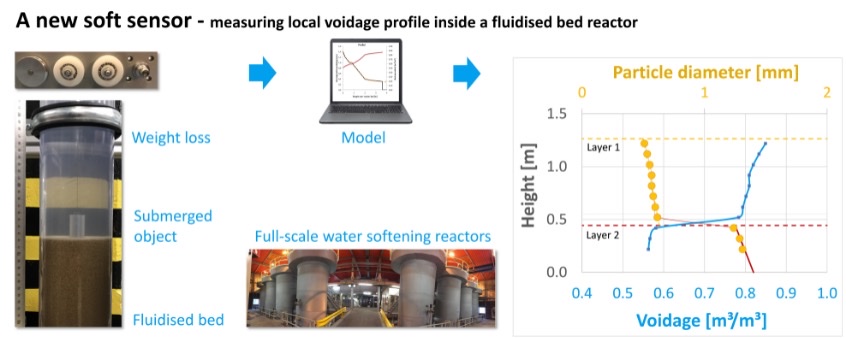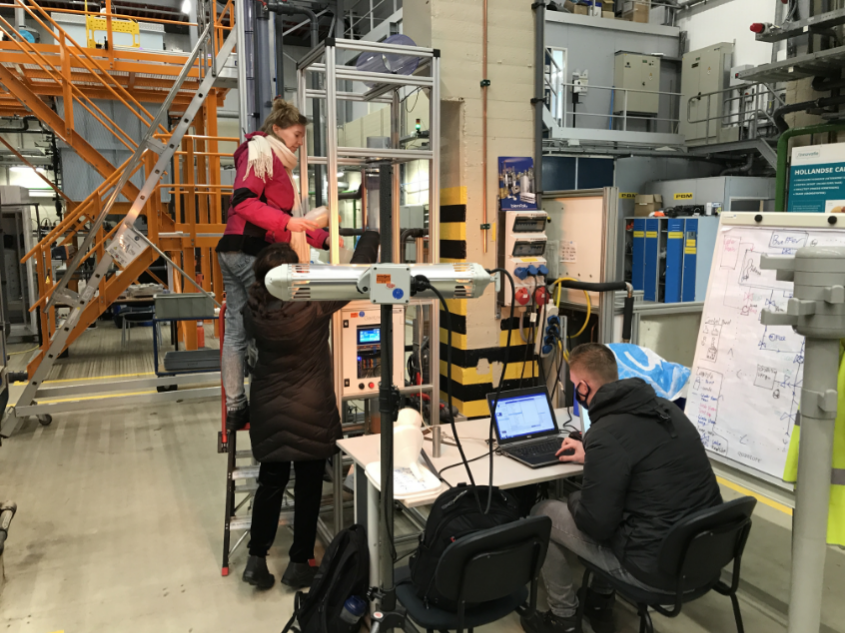Om dit wél te kunnen, hebben we een sensor nodig die als het ware in het proces kan kijken en kan zien of het gaat zoals het zou moeten gaan. Op deze manier kunnen we het proces beter controleren, zodat we kosten en grondstoffen kunnen besparen.
Korrelbed in kaart
Eerst een korte uitleg over het proces. In het onthardingsproces worden korrels van kalk in zwevende toestand gebracht, door water omhoog te pompen in cilindrische reactoren. Dit zogenaamde korrelbed krijgt hierdoor een bijzondere eigenschap, namelijk een zeer grote oppervlakte. Die oppervlakte is nodig om de kalk uit het water te laten aangroeien op die zwevende korrels. De té grote korrels worden afgevoerd en nuttig gebruikt. Daarvoor moeten we te weten komen of de korrels niet te klein, of juist te groot zijn. Dat kunnen we meten met de nieuw te ontwikkelen sensor: de hydrometer. Met de hydrometer kun je het korrelbed in kaart brengen en weet je veel beter hoeveel natronloog je moet toevoegen om de kristallisatie goed te laten verlopen. Zo voorkom je een overdosering van natronloog, zodat negatieve gevolgen voor de waterkwaliteit, de kosten en de duurzaamheid worden vermeden.
Opwaartse kracht meten
Deze sensor berust op het ’onderwatergewicht’. We noemen dit het Archimedes-principe. Archimedes (212 v.Chr.) ondervond dat de opwaartse kracht die een lichaam in een vloeistof ondervindt even groot is als het gewicht van de verplaatste vloeistof. De werking is in principe heel eenvoudig. We laten een object in het zwevende korrelbed hangen en meten de opwaartse kracht. Uit deze meting kunnen we vervolgens allemaal nuttige informatie afleiden, die de prestatie van het proces zichtbaar maakt. Als je een beter beeld hebt van een proces is het ook mogelijk om de werking ervan te verbeteren. Hierdoor neemt de verspilling van grondstoffen af en bespaar je op kosten. We kunnen het proces duurzamer maken.

Samenwerking
Het initiatief is ontstaan bij collega’s van Waternet die op zoek waren naar een procesverbetering. De ontwikkeling en uitvoering is een samenwerkring tussen Waternet, de TU Delft, de Hogeschool Utrecht, de Queen Mary University of London en de firma Bienfait. Veel activiteiten worden uitgevoerd door het Onderzoek en Innovatie team: 'O&I Thema Data en Sensoren'.
Planning
In het najaar van 2022 gaan we een Hydrometer 2.0 testen in de grotere onthardingskolommen in de proefinstallatie te Weesperkarspel. De Hydrometer 1.0 wordt opgenomen in het curriculum van de Hogeschool Utrecht.
Nieuws
- 13/10/22 Roy Duijnmaijer, die is afgestudeerd bij Waternet, heeft de tweede prijs gewonnen “De Gouden Spatel”-afstudeerscriptieprijsvraag van de Koninklijke Chemie Vereniging Nederland.
- 30/6/22 Bo de Groot en Onno gaan een presentatie geven op het Innovatiefestival bij Waternet
- 24/3/22 Roy Duijnmaijer is met zijn afstudeerscriptie genomineerd voor de Gouden Spatel van de KNCV (Koninklijke Nederlandse Chemie Vereniging) door het docententeam van de opleiding Chemische Technologie. De uitslag vindt plaats in oktober 2022
- 15/3/22 Blog van Gantner Instruments
https://www.gantner-instruments.com/blog/the-hydrometer/
- 1/2/22 Bo de Groot is begonnen met haar afstudeeropdracht. Ze gaat de Hydrometer automatiseren.
- 1/12/21 Het is Cas van Schaik en Onno Kramer gelukt de software en de hardware met elkaar te laten 'praten'. Nu kan met een protocol de sensor een gradiënt vaststellen en zodoende het totale korreloppervlakte schatten, dat nodig is voor een goed werkende ontharding.
- 10/9/21 Promotie van Onno Kramer. De Hydrometer is in het proefschrift opgenomen in Hoofdstuk 11 op p311 en staat digitaal op de repository van de TU Delft:
https://doi.org/10.4233/uuid:b49b0f3f-3f23-4179-a17e-2a0c754c53a5
- 5/7/21 Roy Duijnmaijer van de Hogeschool Utrecht is afgestudeerd op de Hydrometer met een 9.4.
- 15/4/21 Ons artikel "A novel sensor measuring local voidage profile inside a fluidised bed reactor" is geaccepteerd in het wetenschappelijk tijdschrift Journal of Water Process Engineering.
https://doi.org/10.1016/j.jwpe.2021.102091
- 1/12/20 De eerste tests zijn uitgevoerd en zie er hoopgevend uit. Precies en nauwkeurig meten is echter niet heel simpel.
- 1/8/20 We zijn ontzettend blij met de ondersteuning van Bienfait voor de onderdelen van de Hydrometer en het gebruik van de industriële software van Gantner Instruments Gmb. Nu kan de Hydrometer helemaal in elkaar worden gezet.
- 1/2/19 Op de Hogeschool Utrecht is geëxperimenteerd met een eerste prille pilotopstelling: letterlijk met en briefwegschaal, visdraadje, stukje ijzer en een waskolom. HU Studenten zijn super fanatiek om het te laten werken. We noemen dit een eerste proof of concept. Mag dit al innovatie heten of is het spelen?
 Het werk met de Hydrometer in de proefinstallatie: Bo de Groot, Fenna Philipse, Mark Joosten, Peter Wind, Mark Heuver, Michel Colin, Bengt van der Sluis en Onno Kramer.
Het werk met de Hydrometer in de proefinstallatie: Bo de Groot, Fenna Philipse, Mark Joosten, Peter Wind, Mark Heuver, Michel Colin, Bengt van der Sluis en Onno Kramer.

Meer lezen
Meerdere wetenschappelijke gerelateerde publicaties:
► O.J.I. Kramer, C. van Schaik, P.D.R. Dacomba-Torres, P.J. de Moel, E.S. Boek, E.T. Baars, J.T. Padding, J.P. van der Hoek, 2021, Fluidisation characteristics of granular activated carbon in drinking water treatment applications, Advanced Powder Technology Journal. 32, Issue 9, (2021) pp. Pages 3174-3188. https://doi.org/10.1016/j.apt.2021.06.017
► O.J.I. Kramer, C. van Schaik, J.J. Hangelbroek, P.J. de Moel, M.G. Colin, M. Amsing, E.S. Boek, W.P. Breugem, J.T. Padding, J.P. van der Hoek, A novel sensor measuring local voidage profile inside a fluidised bed reactor, Journal of Water Process Engineering 41C (2021), pp. 1-15, https://doi.org/10.1016/j.jwpe.2021.102091
► T.M.J. *) Nijssen, O.J.I.*) Kramer, P.J. de Moel, J. Rahman, J.P. Kroon, P. Berhanu, E.S. Boek, K.A. Buist, J.P. van der Hoek, J.T. Padding, J.A.M. Kuipers. Experimental and numerical insights into heterogeneous liquid-solid behaviour in drinking water softening reactors. Chemical Engineering Science: X. 11 (2021), pp. 1-11, https://doi.org/10.1016/j.cesx.2021.100100 *) shared authorship on joint work with equal contribution
► O.J.I. Kramer, P.J. de Moel, J.T. Padding, E.T. Baars, S.B. Rutten, A.H.E. Elarbab, J.F.M. Hooft, E.S. Boek, J.P. van der Hoek, New hydraulic insights into rapid sand filter bed backwashing using the Carman–Kozeny model, Water Research. 197 (2021), pp. 1-35. https://doi.org/10.1016/j.watres.2021.117085
► O.J.I. Kramer, J.T. Padding, W.H. van Vugt, P.J. de Moel, E.T. Baars, E.S. Boek, J.P. van der Hoek, Improvement of voidage prediction in liquid-solid fluidized beds by inclusion of the Froude number in effective drag relations, International Journal of Multiphase Flow. 127 (2020) pp. 1-13. https://doi.org/10.1016/j.ijmultiphaseflow.2020.103261
► O.J.I. Kramer, P.J. de Moel, J.T. Padding, E.T. Baars, Y.M.F. el Hasadi, E.S. Boek, J.P. van der Hoek, Accurate voidage prediction in fluidisation systems for full-scale drinking water pellet softening reactors using data driven models, Journal of Water Process Engineering. 37 (2020) pp. 1-15. https://doi.org/10.1016/j.jwpe.2020.101481
► O.J.I. Kramer, P.J. de Moel, E.T. Baars, W.H. van Vugt, J.T. Padding, J.P. van der Hoek, Improvement of the Richardson-Zaki liquid-solid fluidisation model on the basis of hydraulics, Powder Technology. 343 (2019) pp. 465-478. https://doi.org/10.1016/j.powtec.2018.11.018
► O.J.I. Kramer, P.J. de Moel, S.K.R. Raaghav, E.T. Baars, W.H. van Vugt, W.P. Breugem, J.T. Padding, J.P. van der Hoek, Can terminal settling velocity and drag of natural particles in water ever be predicted accurately?, Drinking Water Engineering Science Journal. 14 (2021), pp. 53-71. https://doi.org/10.5194/dwes-14-53-2021
► M. Beeftink, B. Hofs, O.J.I. Kramer, I. Odegard, A. van der Wal, Carbon footprint of drinking water softening as determined by life cycle assessment. Carbon footprint of drinking water softening as determined by life cycle assessment. Journal of Cleaner Production. 278 (2021), pp. 1-10. https://doi.org/10.1016/j.jclepro.2020.123925
 Het werk met de Hydrometer in de proefinstallatie: Roy Duijnmaijer, Fenna Philipse, Aisha Malik, Mark Joosten, Peter Wind, Mark Heuver, Michel Colin, en Onno Kramer.
Het werk met de Hydrometer in de proefinstallatie: Roy Duijnmaijer, Fenna Philipse, Aisha Malik, Mark Joosten, Peter Wind, Mark Heuver, Michel Colin, en Onno Kramer.
Projectupdate maart 2022
The Hydrometer
Looking inside a drinking water reactor
In the Netherlands, more than 400 million m³ (100 billion gallons) of water is softened in drinking water treatment plants annually. Softening is a complicated physical and chemical process that takes place in fluidised bed reactors. In a fluidised bed, particles of approximately 1 mm, are elevated using an upward water stream creating a large surface area. To maintain optimal process conditions, real-time information is needed about the condition of the fluidised bed. Till now, it is not possible to fully grasp the dynamics of the fluidized bed from the outside of the reactor. For this reason, Waternet, the water supply company for Amsterdam and surrounding areas, has initiated a research program intending to develop an innovative soft sensor (1) - the Hydrometer - that can continuously monitor the state of the fluidised bed inside the reactor. This research is a collaborative initiative together with University of Applied Sciences Utrecht, Queen Mary University of London, TU Delft, Bienfait and Gantner Instruments.
Optimizing the water softening process
The softening process takes place in fluidized bed reactors, which are partially filled with seed material such as sand, garnet, and calcite pellets. Water is pumped in an upward direction, maintaining the pellet bed in a fluidized state. Caustic soda is added as a reagent for calcium carbonate crystallization to take place on the surface of calcite pellets. Crystallization causes the pellets to grow and sink towards to bottom of the reactor. Larger pellets reduce the available surface area which adversely affects the crystallization efficiency. To maintain optimal process conditions, real-time information about the fluidized state of the pellet bed is needed to determine the amount of caustic soda that is required for an optimal crystallization process. This also prevents an overdose of caustic soda usage, which has negative consequences for the water quality, process sustainability, and cost. The aim of Hydrometer soft sensor is to obtain longitudinal information in a fluidized bed reactor and subsequently determine the longitudinal voidage (2) and particle diameter profile using an empirical model.
Hydrometer - proof of concept
The Hydrometer soft sensor is based on the underwater weighing method, also known as Archimedes' principle. Archimedes found that the upward buoyant force on a submerged body was equal to the mass of the displaced liquid. The displaced volume is equal to the volume of the body submerged in the liquid. The Hydrometer is designed to let a submerged floating object hang at different heights in a fluidised calcite pellet bed and measure the buoyancy force at those positions.
.png)
To demonstrate the feasibility of the Hydrometer, Waternet and the University of Applied Sciences Utrecht designed an experimental test setup using a transparent cylinder filled with glass beads and calcite pellets to simulate the softening reactor. A smart pulley sensor designed by Bienfait is mounted above the cylinder to move a floating object controlled by a stepper motor vertically through the fluidised bed. A pulley load cell (P100/3W, Gicam) and an incremental rotary encoder (Rotapulse I28, Lika Electronics) measure the weight and position of the floating object inside the cylinder. The stepper motor, encoder, and load cell are connected to a Q.series measurement and control system consisting of a Q.monixx controller and Q.bloxx D101 digital input module.
The smart pulley sensor comprises four components to move the object up and down the cylinder and measure its weight and position. The floating object is attached to a thin, braided fishing line. The line is strung over the first pulley equipped with the rotary encoder that transmits the number of steps from a set zero point to the Q.bloxx D101 measuring module. The braided line passes under the second pulley equipped with a load cell that measures the amount of strain in voltage. This measured strain has a linear correlation with the mass of the floating object. The braided line is threaded over the third pulley for support and connection to the stepper motor for moving the floating object up and down in the cylinder.
Test system configuration and data recording are done with the GI.bench data acquisition software. The Q.monixx continuously streams data to the GI.bench software running on a PC. Using the sensors scaling feature in GI.bench the measured data from the encoder and load cell are converted from the number of steps [#] to position [m] and strain [V] to mass [kg]. Online dashboards allow the operators to monitor the test in real-time and user-configurable data loggers write the measurement data to file at the optimal sample rate.
To automate the test and ensure repeatable and comparable test results, the engineers from Waternet developed a test.con routine that moves the floating object in pre-defined steps to different heights in the cylinder to take measurements. Test.con is Gantner’s free visual programming language for engineers to create custom applications for test automation and analysis. For the Hydrometer experimental setup, 20 measurements per test run were achieved in approx. 30 min.
Knowledge acquired
The newly developed Hydrometer soft sensor has proven to be a more time-effective method for obtaining the hydraulic state in full-scale fluidised bed reactors. The benefits of a longitudinal sensor for daily process control are real-time access to the particle bed behaviour and greater flexibility with changing water flow and process conditions.
Following proof of concept testing of the Hydrometer, in combination with a data-driven model, voidage could be estimated with an error of 5% and the particle size with approximately 10%. To further improve the accuracy and reliability of the Hydrometer several aspects need further development, amongst others optimising the measurement accuracy in the lower regions of the fluidised bed and adding differential pressure sensors to improve model validation, and applying CFD (computational fluid dynamics) to better model the particle-fluid-object interactions.
Programming a test.con routine in the Q.monixx has benefitted the test results significantly. Besides the number of data points, the optimal interval between measurements could also be determined improving time efficiency of the tests. This may lead to significant improvement in water treatment processes such as more flexible operations, better water quality, fewer risks for approaching undesirable fluidization states, and less chemical usage.
More information
O.J.I. Kramer, C. van Schaik, J.J. Hangelbroek, P.J. de Moel, M.G. Colin, M. Amsing, E.S. Boek, W.P. Breugem, J.T. Padding, J.P. van der Hoek, A novel sensor measuring local voidage profile inside a fluidised bed reactor, Journal of Water Process Engineering 41C (2021), pp. 1-15, https://doi.org/10.1016/j.jwpe.2021.102091
Short video: The development of the Hydrometer
https://youtu.be/KBAxbWMw_vk
Footnote:
(1) A soft sensor is a virtual model that converts various inputs from simple sensors and combines them to mimic the output of a more complex sensor.
(2) Voidage is the fraction of the total volume of the fluidized bed which is free space available for the flow of fluids.
Projectupdate juni 2021
Het wetenschappelijke artikel over de Hydrometer is gepubliceerd:
► O.J.I. Kramer, C. van Schaik, J.J. Hangelbroek, P.J. de Moel, M.G. Colin, M. Amsing, E.S.Boek, W.P. Breugem, J.T. Padding, J.P. van der Hoek, A novel sensor measuring local voidage profile inside a fluidised bed reactor, Journal of Water Process Engineering 41C (2021), pp. 1-15, https://doi.org/10.1016/j.jwpe.2021.102091